Flag of South Korea
The national flag of the Republic of Korea, also known as the Taegeukgi (also spelled as Taegukgi, lit. 'Taiji flag'), has three parts: a white rectangular background, a red and blue Taegeuk in its center, accompanied by four black trigrams, one in each corner. Flags similar to the current Taegeukgi were used as the national flag of Korea by the Joseon dynasty, the Korean Empire, as well as the Korean government-in-exile during Japanese rule. South Korea adopted the Taegeukgi as its national flag when it gained independence from Japan on 15 August 1945.
 | |
| Taegeukgi / Taegukgi (Korean: 태극기, Hanja: 太極旗) | |
| Use | National flag and ensign |
|---|---|
| Proportion | 2:3 |
| Adopted | January 27, 1883 (original version, used by the Joseon dynasty) June 29, 1942 (Provisional Government of the Republic of Korea) October 15, 1949 (as the flag of South Korea)[1] May 30, 2011 (current version) |
| Design | A white field with a centered red and blue taegeuk surrounded by four trigrams |
| Designed by | Lee Eung-jun (Designed) Park Yung-hyo (Selected) Gojong (Approved) |
 | |
| Use | Naval jack |
| Design | A Blue Ensign with a white canton that has a red and blue taegeuk superimposed in the center of the canton, with two anchors crossing. |
| Flag of South Korea | |
| Hangul | 태극기 |
|---|---|
| Hanja | |
| Revised Romanization | Taegeukgi |
| McCune–Reischauer | T'aegŭkki |
Symbolism
The flag's field is white, a traditional color in Korean culture that was common in the daily attire of 19th-century Koreans and still appears in contemporary versions of traditional Korean garments such as the hanbok. The color represents peace and purity.[2]
The circle in the flag's center symbolizes balance in the world. The blue half represents the sky, and the red half represents the land.
Together, the trigrams represent movement and harmony as fundamental principles. Each trigram (hangeul: 괘 [gwae]; hanja: 卦) represents one of the four classical elements,[3] as described below:
| Trigram | Korean name | Celestial body | Season | Cardinal direction | Virtue | Family | Natural element | Meaning |
|---|---|---|---|---|---|---|---|---|
| geon (건 / 乾) |
heaven (천 / 天) |
spring (춘 / 春) |
east (동 / 東) |
wisdom (인 / 仁) |
father (부 / 父) |
air (천 / 天) |
justice (정의 / 正義) | |
| gon (곤 / 坤) |
earth (지 / 地) |
summer (하 / 夏) |
west (서 / 西) |
righteousness (의 / 義) |
mother (모 / 母) |
earth (토 / 土) |
vitality (생명력 / 生命力) | |
| ri (리 / 離) |
sun (일 / 日) |
autumn (추 / 秋) |
south (남 / 南) |
courtesy (례 / 禮) |
daughter (녀 / 女) |
fire (화 / 火) |
fruition (결실 / 結實) | |
| gam (감 / 坎) |
moon (월 / 月) |
winter (동 / 冬) |
north (북 / 北) |
intelligence (지 / 智) |
son (자 / 子) |
water (수 / 水) |
wisdom (지혜 / 智慧) |
History

Background
In 1876, the absence of a national flag became an issue for Korea, at the time reigned over by the Joseon dynasty. Before 1876, Korea did not have a national flag, but the king had his own royal standard. The lack of a national flag became a quandary during negotiations for the Japan–Korea Treaty of 1876, at which the delegate of Japan displayed the Japanese national flag, whereas the Joseon dynasty had no corresponding national symbol to exhibit. At that time, some proposed to create a national flag, but the Joseon government looked upon the matter as unimportant and unnecessary. By 1880, the proliferation of foreign negotiations led to the need for a national flag.[4] The most popular proposal was described in the "Korea Strategy" papers, written by the Chinese delegate Huang Zunxian. It proffered to incorporate the flag of the Qing dynasty of China into that of the Joseon dynasty of Korea. In response to the Chinese proposal, the Joseon government dispatched delegate Lee Young-Sook to consider the scheme with Chinese statesman and diplomat Li Hongzhang. Li agreed with some elements of Huang's suggestion while accepting that Korea would make some alterations. The Qing government assented to Li's conclusions, but the degree of enthusiasm with which the Joseon government explored this proposal is unknown.[1]
The issue remained unpursued for a period but reemerged with the negotiation of the United States–Korea Treaty of 1882, also known as the Shufeldt Treaty. The US emissary Robert Wilson Shufeldt suggested that Korea adopt a national flag to represent its sovereignty. The king of Joseon, Kojong, ordered government officials Sin Heon and Kim Hong-jip to begin working on a new flag. Kim Hong-jip in turn asked delegate Lee Eung-jun to create the first design, which Lee Eung-jun presented to the Chinese official Ma Jianzhong. Ma Jianzhong argued against Huang Zunxian's proposal that Korea adopt the flag of the Qing dynasty, and proposed a modified dragon flag.[1] Kojong rejected this idea.[5] Ma suggested Lee Eung-jun's Taegeuk and Eight Trigrams flag.[6] Kim and Ma proposed changes to it: Kim proposed changing the red to blue and white; Ma proposed a white field, a red and black Taegeuk, black Eight Trigrams, and a red border.[1] On 14 May 1882, before the Joseon–United States Treaty of 1882, Park Yeong-hyo presented a scale model of the Lee Eung-jun's Taegukgi to the Joseon government. And Gojong approved Lee Eung-jun's taegukgi. Park Yeong-hyo became the first person to use the Taegukgi in 1882. The 2 October 1882 issue of the Japanese newspaper Jiji shimpō credited Gojong as the designer of the Taegukgi (i.e., a flag with a red and blue Taegeuk and four trigrams).[8] On 27 January 1883, the Joseon government officially promulgated the Taegukgi to be used as the official national flag.[1]
In 1919, a flag similar to the current South Korean flag was used by the provisional Korean government-in-exile based in China. Under colonial rule, the Taeguk and Korean flag grew as a powerful symbol of independence in the 1,500 demonstrations taken place.
After the restoration of Korean independence in 1945, the Taegukgi remained in use after the southern portion of Korea became a republic under the influence of the United States but also used by the People's Republic of Korea. At the same time, the flag of the United States was also used by the United States Army Military Government in Korea along with the Taegukgi. Following the establishment of the South Korean state in August 1948, the current flag was declared official by the government of South Korea on 15 October 1949,[1] although it had been used as the de facto national flag before then.[9]
In February 1984, the exact dimensional specifications of the flag were codified.[10][11][12][13] In October 1997, the precise color scheme of the flag was fixed via presidential decree for the first time.[2][14]
Cultural role in contemporary South Korean society
The name of the South Korean flag is used in the title of a 2004 film about the Korean War, Tae Guk Gi.
Observers such as The Times Literary Supplement's Colin Marshall and Korea scholar Brian Reynolds Myers have noted that the South Korean flag in the context of the country's society is often used as an ethnic flag, representing a grander nationalistic idea of a racialized (Korean) people rather than merely symbolizing the (South Korean) state itself as national flags do in other countries.[15][16] Myers argues that: "When the average [South Korean] man sees the [South Korean] flag, he feels fraternity with [ethnic] Koreans around the world."[17] Myers also stated in a 2011 thesis that: "Judging from the yin-yang flag's universal popularity in South Korea, even among those who deny the legitimacy of the Republic of Korea, it evidently evokes the [Korean] race first and the [South Korean] state second."[18]
Desecration
The South Korean flag is considered by a large part of the country's citizens to represent the "Korean race" rather than solely the South Korean state; consequently flag desecration by the country's citizens is rare when compared to other countries, where citizens may desecrate their own national flags as political statements. Thus those South Korean citizens opposed to the state's actions or even its existence will still treat their national flag with reverence and respect: "There is therefore none of the parodying or deliberate desecration of the state flag that one encounters in the countercultures of other countries."[18]
Regardless of frequency, the South Korean Criminal Act punishes desecration of the South Korean national flag in various ways:[19]
- Article 105 imposes up to 5 years in prison, disfranchisement of up to 10 years, or a fine up to 7 million South Korean won for damaging, removing, or staining a South Korean flag or emblem with intent to insult the South Korean state. Article 5 makes this crime punishable, even if done by aliens outside South Korea.
- Article 106 imposes up to 1 year in prison, disfranchisement of up to 5 years, or a fine up to 2 million South Korean won for defaming a South Korean flag or emblem with intent to insult the South Korean state. Article 5 makes this crime punishable, even if done by aliens outside South Korea.
South Korea also criminalizes not just desecration of the South Korean flag, but the flags of other countries as well:
- Article 109 imposes up to 2 years in prison or a fine up to 3 million South Korean won for damaging, removing, or staining a foreign flag or emblem with intent to insult a foreign country. Article 110 forbids prosecution without foreign governmental complaint.
Specifications
.svg.png.webp)
Dimensions
.svg.png.webp)
The width and height are in the ratio of 3 to 2. There are five sections on the flag, the taegeuk and the four groups of bars. The diameter of the circle is half of the height. The top of the taegeuk should be red and the bottom of the taegeuk should be blue. The groups of bars are put in the four corners of the flag.[20]
Colors
.svg.png.webp)
The Taegukgi's colors are specified in the "Ordinance Act of the Law concerning the National Flag of the Republic of Korea." (Korean: 대한민국 국기법 시행령)[22] The color scheme was unspecified until 1997, when the South Korean government decided to standardize specifications for the flag. In October 1997, a Presidential ordinance on the standard specification of the South Korean flag was promulgated, and that specification was acceded by the National Flag Law in July 2007.
Colors are defined in legislation by the Munsell and CIE color systems as follows:
| Scheme | Munsell[24] | CIE (x, y, Y)[24] | Pantone[21] | Hex triplet (converted from CIE)[24] |
|---|---|---|---|---|
| White | N 9.5 | — | — | #FFFFFF |
| Red | 6.0R 4.5/14 | 0.5640, 0.3194, 15.3 | 186 Coated | #CD2E3A |
| Blue | 5.0PB 3.0/12 | 0.1556, 0.1354, 6.5 | 294 Coated | #0047A0 |
| Black | N 0.5 | — | — | #000000 |
Gallery
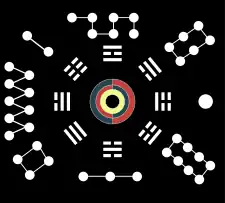
 Ensign of the Joseon dynasty navy
Ensign of the Joseon dynasty navy

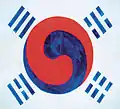
 Taegukgi by Park Yeong-hyo (September 1882)
Taegukgi by Park Yeong-hyo (September 1882).svg.png.webp)
 Taegukgi published in U.S. Navy book Flags of Maritime Nations in July 1882
Taegukgi published in U.S. Navy book Flags of Maritime Nations in July 1882.svg.png.webp)
 Taegukgi (November 1882)
Taegukgi (November 1882)
 Taegukgi (March 1883). "The flag of Goryeo belonging to the Great Qing" is written in Chinese characters. Joseon was often called 'Goryeo' in China.
Taegukgi (March 1883). "The flag of Goryeo belonging to the Great Qing" is written in Chinese characters. Joseon was often called 'Goryeo' in China..svg.png.webp)
 Taegukgi by O. N. Denny (1888)
Taegukgi by O. N. Denny (1888).svg.png.webp)
 Taegukgi (1893)
Taegukgi (1893).svg.png.webp)
 The flag of the Korean Empire (1897–1910)
The flag of the Korean Empire (1897–1910)
 Imperial standard of the Korean Empire (1897–1910)
Imperial standard of the Korean Empire (1897–1910)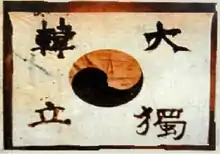
 A flag made by Ahn Jung-Geun, a Korean independence activist who died in 1910. "大韓獨立(The independence of Greater Korea)" is written.
A flag made by Ahn Jung-Geun, a Korean independence activist who died in 1910. "大韓獨立(The independence of Greater Korea)" is written..svg.png.webp)
 Flag of the Provisional Government of the Republic of Korea used in 1919 during the March 1st Movement
Flag of the Provisional Government of the Republic of Korea used in 1919 during the March 1st Movement
 Flag of the Provisional Government of the Republic of Korea from 1919 to 1948 used in exile in China
Flag of the Provisional Government of the Republic of Korea from 1919 to 1948 used in exile in China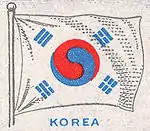
 Older version of the Taegukgi on a U.S. postage stamp (1944)
Older version of the Taegukgi on a U.S. postage stamp (1944)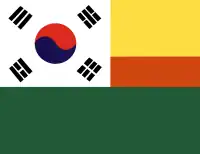
 A marching flag kept by the commander of the Independence Army
A marching flag kept by the commander of the Independence Army
 The flag of the People's Republic of Korea from August 1945 to December 1945, when the USAMGIK outlawed the PRK
The flag of the People's Republic of Korea from August 1945 to December 1945, when the USAMGIK outlawed the PRK.svg.png.webp)
 The flag of the United States used during the U.S. military occupation of the southern part of Korea from 1945–1948
The flag of the United States used during the U.S. military occupation of the southern part of Korea from 1945–1948.svg.png.webp)
 The flag of southern Korea from 1945 to 1948. This flag is similar to the current South Korean flag with the exception of a smaller version of the Taegeuk.
The flag of southern Korea from 1945 to 1948. This flag is similar to the current South Korean flag with the exception of a smaller version of the Taegeuk..svg.png.webp)
 Post-independence South Korean flag from 1948 to 1949
Post-independence South Korean flag from 1948 to 1949.svg.png.webp)
 1949–1984
1949–1984.svg.png.webp)
 1984–1997
1984–1997.svg.png.webp)
 1997–2011
1997–2011 2011–present
2011–present The flag of the Republic of Korea Army
The flag of the Republic of Korea Army The flag of the Republic of Korea Air Force
The flag of the Republic of Korea Air Force The flag of the Republic of Korea Marine Corps
The flag of the Republic of Korea Marine Corps The Unification Flag of North and South Korea
The Unification Flag of North and South Korea The flag of the Government of the Republic of Korea
The flag of the Government of the Republic of Korea.jpg.webp) A large display of the South Korean flag during an association football match against Haiti
A large display of the South Korean flag during an association football match against Haiti.jpg.webp) A series of South Korean flags flying on street
A series of South Korean flags flying on street
See also
References
- 태극기 [Taegukgi] (in Korean). Academy of Korean Studies. Retrieved 5 November 2013.
- "National Administration : National Symbols of the Republic of Korea : The National Flag – Taegeukgi". Mois.go.kr. Retrieved 9 January 2018.
- "The World Factbook". Central Intelligence Agency. Retrieved 4 November 2013.
- "대한민국[Republic of Korea,大韓民國]" (in Korean). Doosan Corporation. Retrieved 5 November 2013.
- "대한민국의 국기". terms.naver.com (in Korean). Retrieved 20 December 2020.
- Wang, Yuanchong (15 December 2018). Remaking the Chinese Empire: Manchu-Korean Relations, 1616–1911. Cornell University Press. p. 154. ISBN 978-1-5017-3051-1.
For Chosŏn's national flag, Ma suggested Yi Ŭngjun's design of the Taiji and eight trigrams as the basic model.
- ""태극기는 천손민족의 표시..중국보다 앞서"". 오마이뉴스 (in Korean). 20 April 2007. Retrieved 20 December 2020.
- "National Flag of North Korea". Worldflags 101. Retrieved 5 November 2013.
- "History of the South Korean flag". fotw.fivestarflags.com.
- "flag of Korea, South". Encyclopedia Britannica.
- "History of the South Korean flag". Christusrex.org. Archived from the original on 26 March 2017. Retrieved 9 January 2018.
- "Flag History". Destination South Korea. Retrieved 9 January 2018.
- "NATIONAL SYMBOLS OF THE REPUBLIC OF KOREA". Mois.go.kr. Retrieved 9 January 2018.
- Archived at Ghostarchive and the Wayback Machine: O'Carroll, Chad (2014). "BR Myers – Current Issues". YouTube. Retrieved 11 September 2017.
[T]he South Korean flag continues to function, at least in South Korea, not as a symbol of the state but as a symbol of the race.
- Marshall, Colin (2017). "How Korea got cool: The continued rise of a country named Hanguk". The Times Literary Supplement. Retrieved 24 June 2019.
When people wave the South Korean flag, in other words, they wave the flag not of a country but of an [ethnic] people.
- "North Korea's Unification Drive— B.R. Myers". Sthele Press. 20 December 2017. Retrieved 9 January 2018.
- Myers, Brian Reynolds (2011). "North Korea's state-loyalty advantage". Free Online Library. Archived from the original on 20 May 2018. Retrieved 29 May 2018.
- "Criminal Act". South Korean Laws. 14 May 2014. Retrieved 3 January 2017.
- "국가상징 > 태극기 > 태극기 더보기 > 국기의 제작". Theme.archives.go.kr. Retrieved 9 January 2018.
- "National Flag". infokorea.ru. The Embassy of the Republic of Korea in Moscow. Archived from the original on 18 January 2012. Retrieved 6 August 2017.
{{cite web}}: CS1 maint: bot: original URL status unknown (link) - 대한민국국기법 시행령 [The law concerning practice for the flag of the Republic of Korea] (in Korean). Government of the Republic of Korea. Retrieved 6 August 2017.
- 국기의 제작 [Geometry of the National Flag] (in Korean). Ministry of the Interior and Safety. 2017. Retrieved 6 August 2017.
- http://internationalcongressesofvexillology-proceedingsandreports.yolasite.com/resources/23rd/Kariyasu-TheHistoryofTaegeukFlags.pdf
External links
 Media related to National flag of South Korea at Wikimedia Commons
Media related to National flag of South Korea at Wikimedia Commons Quotations related to Flag of South Korea at Wikiquote
Quotations related to Flag of South Korea at Wikiquote Korean Wikisource has original text related to this article: 대한민국 대한민국국기법
Korean Wikisource has original text related to this article: 대한민국 대한민국국기법- South Korea at Flags of the World